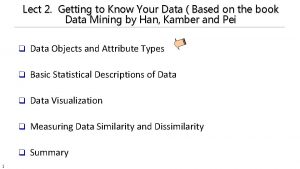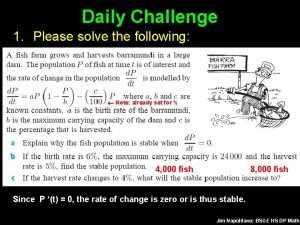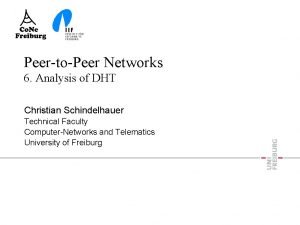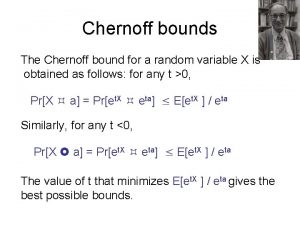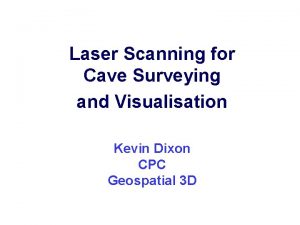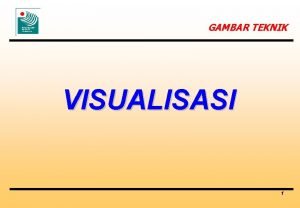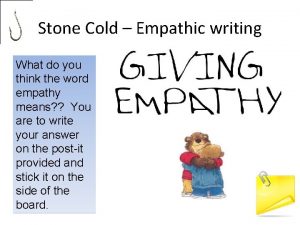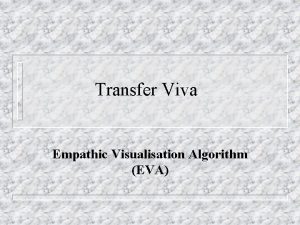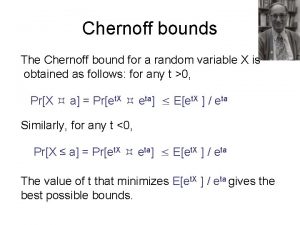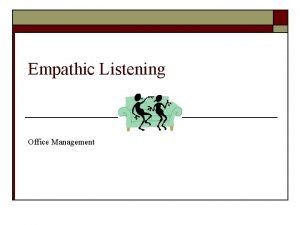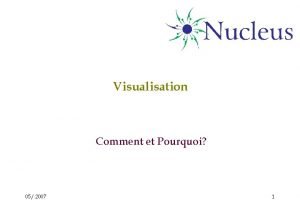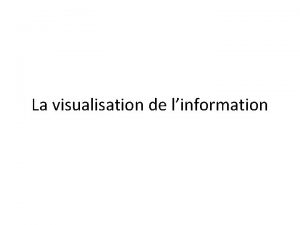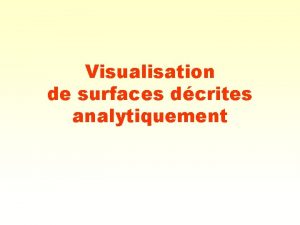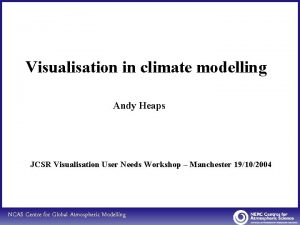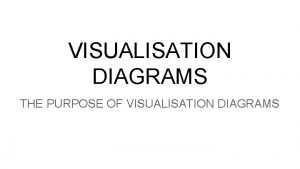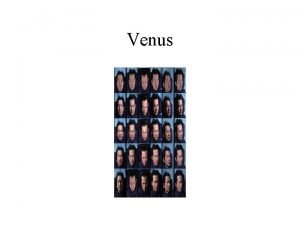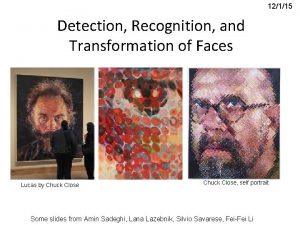The Empathic Visualisation Algorithm EVA Chernoff faces revisited




















- Slides: 20

The Empathic Visualisation Algorithm (EVA): Chernoff faces revisited Andreas Loizides Mel Slater University College London


Motivation • For 2, 3 variables graphs and spreadsheets are very • effective What about when you have 5, 10, 20, 70 variables? The number of variables is too large to be directly encoded into an orthogonal visual structure

Motivation: Problems with existing techniques • Complexity of systems increases with dimensionality • Requires user learning time • Very hard to visualise relationships beyond quadratic • Don’t get a meaningful holistic view of your data

Chernoff Faces • Mapping data variables onto features of schematic faces His idea capitalises on 2 important principles: • Familiarity with human faces and our ability to process even the smallest changes due to everyday interaction • A face evokes an emotional response in us • Psychological research indicates that the human face can be an excellent abstraction of data [Walker, Wilkinson, Homa]

Chernoff Faces Problems: • Variables treated uniformly • User training is required • You don’t see the actual values • Loses effectiveness for extreme values • Subjectiveness of visual structure

Empathic Visualisation Algorithm • Differs from Chernoff faces • Automatic derivation from data • Emotion in the face reflects importance in the data • Faces are only one example

Empathic Visualisation Algorithm: EVA • data matrix of “quantifiable” variables Variables cases on

Objective Overall: Construct a visualisation such as the salient features of the data can intuitively be recognised by an observer and representation gives an overall view of the data set Two further objectives: • Naturalistic visual representation; something encountered in everyday life • Automatic Mapping; semantically important features in the data are mapped to perceptually or emotionally important features of the visual structure -> Visual Homomorphism

Value system (chosen by user) Given Profit over Total Assets Current Ratio (short term liquidity) Global characteristics of Visual Structure Measured I am happy I am angry

Visual Homomorphism Find a mapping: • Global characteristics of the data correspond to the emotional expressions of the face: • (The company is profitable – I am happy)

How? DATA Feature functions FACE muscle contractions Zygomatic major Left frontalis inner ……… • Feature functions determine muscle contractions • One set of r feature functions face

How do we choose the feature functions? Population of N sets of feature functions Happy Angry X 75% 12% distance . . . i Profitability Liquidity distance 34% 77%

Same for row j Population of N sets of Feature functions Happy Angry X 24% 67% distance . . . j Profitability Liquidity distance 74% 27%

Error Measurement • Error • for an individual set of feature functions = sum of squared distances over all rows • Fitness • For an individual set of feature functions may be derived from the errors • Used to determine probabilities of selection

Genetic Program GP • Choose first generation of feature functions as random functions over the variables • Next generation uses probabilities based on fitness, to determine survival: • Selection for Reproduction and Mating • Repeat for each new generation • Greater fitness greater match between global characteristics of data and characteristics of face



Conclusions • You get a quick understanding of the overall impact of the data • Automatically map multidimensional data to human faces using GP • Complementary not an alternative to statistical analysis and other techniques • Visualising the data matrix as a whole

Empathic Visualisation Algorithm Questions
 Chernoff faces
Chernoff faces Math lesson
Math lesson Zhuoyue zhao
Zhuoyue zhao Chernoff bound
Chernoff bound Igor nor
Igor nor Chernoff bound
Chernoff bound Chernoff bound
Chernoff bound Mona chalabi charts
Mona chalabi charts Total station visualisation
Total station visualisation Qperm
Qperm Visualisasi isometrik
Visualisasi isometrik Visualisation
Visualisation Sunflower cataract
Sunflower cataract What would a visualisation diagram be used for
What would a visualisation diagram be used for Pre production visualisation diagram
Pre production visualisation diagram It has six faces, eight vertices and twelve edges
It has six faces, eight vertices and twelve edges How to write an empathic response
How to write an empathic response How to write an empathy essay
How to write an empathy essay Empathic writing
Empathic writing Empathic neutrality
Empathic neutrality Empathic anger definition
Empathic anger definition
